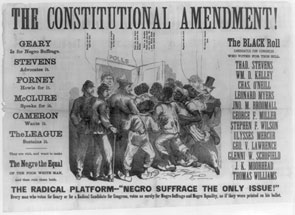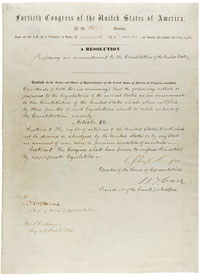The Fifteenth Amendment in Flesh and Blood
The Symbolic Generation of Black Americans in Congress, 1870–1887
Introduction
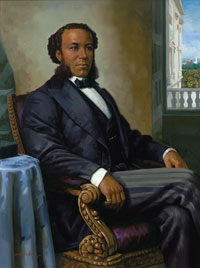 Joseph Rainey of South Carolina, the first black Representative in Congress, earned the distinction of also being the first black man to preside over a session of the House, in April 1874.Oil on canvas, Simmie Knox, 2004, Collection of U.S. House of Representatives
Joseph Rainey of South Carolina, the first black Representative in Congress, earned the distinction of also being the first black man to preside over a session of the House, in April 1874.Oil on canvas, Simmie Knox, 2004, Collection of U.S. House of RepresentativesWhen Senator Hiram Revels of Mississippi—the first African American to serve in Congress—toured the United States in 1871, he was introduced as the “Fifteenth Amendment in flesh and blood.”1 Indeed, the North Carolina-born preacher personified African-American emancipation and enfranchisement. On January 20, 1870, the state legislature chose Revels to briefly occupy a U.S. Senate seat, previously vacated by Albert Brown when Mississippi seceded from the Union in 1861.2 As Senator Henry Wilson of Massachusetts escorted Revels to the front of the chamber to take his oath on February 25, the Atlanta Constitution reported that “the crowded galleries rose almost en masse, and each particular neck was stretched to its uttermost to get a view. A curious crowd (colored and white) rushed into the Senate chamber and gazed at the colored senator, some of them congratulating him. A very respectable looking, well dressed company of colored men and women then came up and took Revels captive, and bore him off in glee and triumph.”3 The next day, the Chicago Tribune jubilantly declared that “the first letter with the frank of a negro was dropped in the Capitol Post Office.”4 But Revels’s triumph was short-lived. When his appointment expired the following year, a leading white Republican, former Confederate general James Alcorn, took his place for a full six-year term.
In many respects, Revels’s service foreshadowed that of the black Representatives who succeeded him during Reconstruction—a period of Republican-controlled efforts to reintegrate the South into the Union. They, too, were largely symbols of Union victory in the Civil War and of the triumph of Radical Republican idealism in Congress. “[The African-American Members] have displaced the more noisy ‘old masters’ of the past,” a reporter with the Chicago Tribune wrote, “and, in their presence in [Congress], vindicate the safety of the Union which is incident to the broadest freedom in political privileges.”5 The African-American Representatives also symbolized a new democratic order in the United States. These men demonstrated not only courage, but also relentless determination. They often braved elections marred by violence and fraud. With nuance and tact they balanced the needs of black and white constituents in their Southern districts, and they argued passionately for legislation promoting racial equality. However, even in South Carolina, a state that was seemingly dominated by black politicians, African-American Members never achieved the level of power wielded by their white colleagues during Reconstruction. Though pushed to the margins of the institutional power structure, the black Representatives nevertheless believed they had an important role as advocates for the United States’s newest citizens.
Reconstruction’s New Order
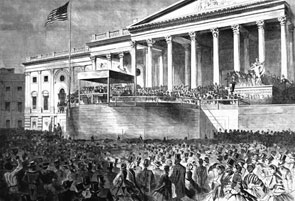 President Abraham Lincoln became a symbol of hope for African Americans. Harper’s Weekly published this image, shown here in detail, of the crowd gathered at the Capitol for Lincoln’s first inauguration in 1861.Collection of U.S. House of Representatives
President Abraham Lincoln became a symbol of hope for African Americans. Harper’s Weekly published this image, shown here in detail, of the crowd gathered at the Capitol for Lincoln’s first inauguration in 1861.Collection of U.S. House of RepresentativesOn New Year’s Day 1863, Republican President Abraham Lincoln signed the Emancipation Proclamation, freeing slaves in captured portions of the Confederacy, and changing the goal of the two-year-old Civil War from one of suppressing a rebellion and preserving the Union to bringing a new order to the United States.6 The North’s victory in 1865 elated the newly freed slaves, but their freedom also generated new questions about the future economic and political landscape of the South. Sweeping change transformed the former Confederacy in the decade that followed, as the Northern victors in Congress experimented with ways to reconcile with their former enemies.7
Radical Republicans were the driving force in Congress in the waning days of the Civil War. Primarily former abolitionists who represented Northern constituencies, these politicians looked to implement in the postwar South their “utopian vision of a nation whose citizens enjoyed equality of civil and political rights, secured by a powerful and beneficent state.”8 They emphasized the political equality of American men, yet with few exceptions, stopped short of calling for the social integration of the races. The venerable Charles Sumner of Massachusetts—a fiery, well-spoken abolitionist who endured an infamous beating from South Carolina Representative Preston Brooks on the Senate Floor in 1856— led the Radical Republicans in the Senate. Pennsylvania Representative Thaddeus Stevens—caustic, brooding, and a brilliant political strategist—led the charge in the House. Sumner and Stevens hoped Democratic President Andrew Johnson, who succeeded the assassinated President Lincoln in April 1865, would be even more harsh than Lincoln in readmitting Confederate states. But Johnson believed in limited federal intervention and did not share the Radical Republicans’ sweeping vision of freedmen’s rights. The President’s plan granted amnesty to repentant former Confederates and turned southern politics over to Union loyalists. The administration and the congressional majority were soon at odds. Of the 29 vetoes issued by Johnson—many involving Reconstruction bills—15 were overridden, more than for any other President.9
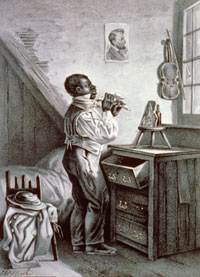 This 1868 Currier & Ives print, titled “The Freedman’s Bureau,” featured a young man dressing for a visit to Congress. An ambivalent image highlighting both the subject’s conscientiousness and low economic status, this commercial decorative print reflected the complex attitudes toward African Americans during the period.Image courtesy of Library of Congress
This 1868 Currier & Ives print, titled “The Freedman’s Bureau,” featured a young man dressing for a visit to Congress. An ambivalent image highlighting both the subject’s conscientiousness and low economic status, this commercial decorative print reflected the complex attitudes toward African Americans during the period.Image courtesy of Library of CongressUnable to circumvent Johnson, Radical Republicans sought to remove him. In January 1867, Republican Representative James M. Ashley of Ohio introduced a resolution, adopted by the House, instructing the Judiciary Committee to “inquire into the conduct of Andrew Johnson,” with an eye toward impeaching the President. The committee initially rejected the measure. But in September 1867, after President Johnson attempted to dismiss Secretary of War Edwin Stanton—who opposed Johnson’s Reconstruction plan and worked closely with congressional Radicals—the committee recommended impeachment proceedings in a 5 to 4 vote, claiming Johnson had violated the Tenure of Office Act (14 Stat. 430–432). The full House rejected that report, but Johnson was bent on confronting Congress. In February 1868, when the President again tried to dismiss Stanton, congressional retribution was swift. The House voted 126 to 47 to impeach President Johnson, though the Senate later acquitted him by a single vote.
Even in the face of presidential intransigence, the Radical Republicans imposed a bold agenda of strict reforms upon the former Confederacy. Collectively, their push for African-American political rights surpassed any measure ever seen in the United States. The 38th Congress (1863–1865) quickly passed and submitted for ratification the 13th Amendment (13 Stat. 744–775)—outlawing slavery—in 1865. That same year, Congress established the Freedmen’s Bureau (13 Stat. 507–509), which was charged with preparing the newly freed slaves for civic life by providing social services and education. In 1866, the 39th Congress (1865–1867) passed the first Civil Rights Bill (14 Stat. 27–30), granting American citizenship to freed slaves, and then expanded upon the legislation by approving the 14th Amendment (14 Stat. 358–359), which enforced the equality of all citizens before the law. On the final day the House met during the 39th Congress, the Radicals divided the former Confederacy into five military districts, each commanded by a U.S. Army general and ruled by military law. The act also provided strict conditions for re-admission to the Union: each of the 10 remaining Confederate states was required to rewrite its constitution at a convention attended by black and white delegates, to guarantee black suffrage, and to ratify the 14th Amendment.10 In a rare move, the 40th Congress (1867–1869) convened minutes after the 39th Congress adjourned and quickly granted greater authority to the commanders of each military district by vesting them with considerable powers to hold elections and determine citizens’ eligibility to vote. The 15th Amendment (16 Stat. 40–41), which passed in 1869, enforced the right to vote for eligible African-American men. Thus, in an effort to achieve their ambitious vision for a racially transformed South, Radical Republicans drastically changed the status of southern blacks; within the space of a decade, millions who formerly had been classified as property exercised their new rights as voters and potential officeholders.11
After the ratification of the 15th Amendment, former slaves flocked to the ballot boxes and the more ambitious sought political office. By 1877 about 2,000 black men had won local, state, and federal offices in the former Confederate states.12 But although black voters formed the bulk of the Republican constituency in the former Confederacy, black officeholders never achieved significant power within the GOP ranks. Nor did any southern state elect black officeholders in proportion to its African-American population. Finally, black politicians never controlled a government at the state level during the Reconstruction Era even though the populations in several states were majority black.
Footnotes
- Quoted in Maurine Christopher, Black Americans in Congress (New York: Thomas Y. Crowell Company, 1976): 9. Revels seems to attribute this quote to Massachusetts journalist Wendell Phillips. See “Autobiography of Hiram Revels,” Carter G. Woodson Collection of Negro Papers and Related Documents, box 11, Manuscript Division, Library of Congress, Washington, DC.
- U.S. Senators were elected by state legislatures until 1913, when the adoption of the 17th Amendment required their direct election. Jefferson Davis, formerly the President of the Confederacy, left his Senate seat at the same time Brown left his. The Union victors in the Civil War were quick to elevate Revels’s place in the chamber, representing the state that once selected Davis, as a symbolic moment; they played their message so well that contemporary newspapers and many historians mistakenly place Revels in Davis’s former seat. See, for example, Congressional Globe, Senate, 41st Cong., 2nd sess. (23 February 1870): 1513; Gath, “Washington,” 17 March 1870, Chicago Tribune: 2; Maurine Christopher, Black Americans in Congress (New York: Thomas Y. Crowell Company, 1976): 5–6; Stephen Middleton, ed., Black Congressmen During Reconstruction: A Documentary Sourcebook (Westport, CT: Praeger, 2002): 320.
- “The Negro United States Senator,” 3 March 1870, Atlanta Constitution: 3.
- “Washington,” 27 February 1870, Chicago Tribune: 1.
- “The Negro in Congress,” 7 March 1871, Chicago Tribune: 2.
- President Lincoln issued a preliminary version of the Emancipation Proclamation on September 22, 1862, after the Civil War battle of Antietam. In his message to the Confederacy, the President announced his intention to free the slaves in the rebellious states; one hundred days later he signed the official proclamation. For more information on the history of both proclamations, see James M. McPherson, Crossroads of Freedom: Antietam (New York: Oxford University Press, 2002): 138–146; James M. McPherson, Battle Cry of Freedom (New York: Oxford University Press, 1988): 562–563. See also the National Archives and Records Administration’s online “Featured Documents” at http://www.archives.gov/exhibits/featured_documents/emancipation_proclamation/(accessed 13 May 2008).
- The Confederacy originally included 11 states (South Carolina, Mississippi, Florida, Alabama, Georgia, Louisiana, Texas, Virginia, Arkansas, North Carolina, and Tennessee).
- Eric Foner, Reconstruction: America’s Unfinished Revolution, 1863–1877 (New York: Harper & Row, 1988): 230.
- This includes the 21 formal vetoes and eight pocket vetoes issued by Johnson in the 39th and 40th Congresses (1865–1869). Johnson had the second-highest percentage of vetoes overridden (51.7 percent). Franklin Pierce, who had 55.7 percent of his vetoes overridden, issued nine vetoes only to have five overridden by the 33rd and 34th Congresses (1853–1857). See Office of the Clerk, “Presidential Vetoes,” available at http://clerk.house.gov/art_history/house_history/vetoes.html.
- Tennessee, which had rejoined the Union on July 24, 1866, was exempt from the requirements of the Reconstruction Act.
- See Appendix J, Constitutional Amendments and Major Civil Rights Acts of Congress Referenced in the Text.
- Eric Foner, Freedom’s Lawmakers: A Directory of Black Officeholders During Reconstruction (New York: Oxford University Press, 1993): xi.


